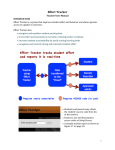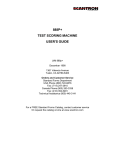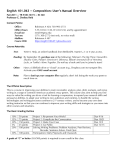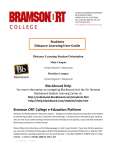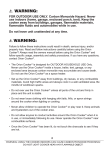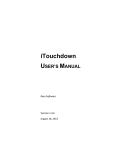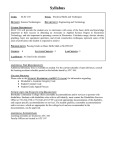Download Effort Tracker - s3.amazonaws.com
Transcript
Effort Tracker SECTION 1 of Teacher User Manual INTRODUCTION Effort Tracker is a system that improves student effort and behavior. Scores are updated in real-‐time to allow for frequent student and parent review. Effort Tracker Features ★ Participation category with three separate student buckets/pools; ★ Recognition category/program -‐ recognizes and rewards recent and consistent student effort; ★ Data Reports -‐ summary tables generated from student scores for teacher use; ★ Student Report Page -‐ updated in real time for student and parent review; ★ No limit on number of classes; ★ No limit on number of students per class; ★ Setup is easy -‐ log on to your account from a laptop or desktop computer; Effort Tracker Pro Features Our Pro version provides a more complete representation of student effort. It includes all of the Free features plus three additional effort categories. ★ On-task -‐ increase student accountability by easily scoring learning tasks; ★ Ready? -‐ score student adherence to start-‐class expectations; ★ Class Rules - record student level of compliance; Use it to help drive positive behavior by acknowledging individual and class improvement or sustained excellence; ★ Two categories can be renamed to allow teachers to customize their Effort Tracker app; 1 Effort Tracker Section 1 of Teacher User Manual This is just Section 1 of the User Manual. The subtopics for Sections 2 and 3 are provided here as a reference Section 1 EFFORT TRACKER CATEGORIES, Pages: 4 - 14 Effort Tracker has one category for scoring student effort and one category for recognizing student effort. Effort Tracker Pro has four categories for scoring student effort and one category for recognizing student effort. The ?ive categories are explained in the following sections: 1.1 Participation 1.2 Recognition 1.3 On-task 1.4 Ready? 1.5 Class Rules (Basic and Pro versions) (Basic and Pro versions) (Pro version) (Pro version) (Pro version) 2.1 The Overview Tab and entering Effort Tracker data into your electronic grade book 2.2 Titled Events 2.3 Effort Awards 2.4 Effort Achievers 2.5 Scores By Date 2.6 Print Student Reports 2.7 Viewing or changing individual student data 4 9 11 14 14 Section 2 DATA REPORTS Section 3 SETUP 3.1 Setup menu items 3.2 Checking/changing individual student data 2 Quick Reference 11 1 2 10 3 4 5 9 6 8 7 Item # Function 1 Lists current class/subject. Touch this button to get back to your list of classes or subjects. (The image shows the “Demo” class which is included with each Effort Tracker account.) 2 This row shows the five category choice buttons. Participation (Partcp) is currently selected. 3 The highlighted student will be scored when you make a selection from the scorepad (#7). 4 Numbers after student names represent their assigned seat (group 6 seat 3). 5 Pressing the reset button will generate a new random listing of all students in the class. 6 Pressing the save button will move pending scores to the Effort Tracker server. 7 The scorepad showing your scoring options. The score value that is chosen will appear on the right side (see #10). Scoring options can be changed (see section 3.1). 8 Selecting filldown will give the previous score to the remaining unscored students. 9 Use to keep track of how often students are absent when their turn occurs. 10 Pending or saved scores are shown here. To change a score before saving, touch the studentʼs name and the highlighter will relocate to that student. 11 The Participation category has three separate randomly-‐ordered student lists or pools: L1, L2, and L3 (see section 1.1). 3 Getting Started After you sign in you will see the welcome page. Select Effort Tracker. Figure 1 The second screen lists your classes along with My account/Sign out. Choose a class to get started (or the Demo class to practice). Section 1 EFFORT TRACKER CATEGORIES To get stated using Effort Tracker, you will need to: a) name your ?irst Time Period, b) enter your classes or subjects, and c) enter your students and assign them to one or more classes or subjects. Just follow the directions at the top of each screen when you ?irst sign up for Effort Tracker. After signing in to your Effort Tracker account, click on Effort Tracker and your list of classes or subjects will appear (Figure 1). Select a class or subject and a screen similar to Figure 2 will appear. Effort Tracker Pro has four categories for scoring student effort or class work and one for recognizing student performance. We will begin with the opportunity-‐equalizing category, Participation. 1.1 Participation (Effort Tracker and Effort Tracker Pro) This category is used to equalize student participation opportunities. It allows you to randomly call on students and score their effort. Use Participation to call on students to answer questions, make predictions, offer opinions, read aloud, etc. Figures 2 and 3 are examples of the screens that are used for scoring student effort in the Participation category. You will know that you are in this category because the second button at the top (Partcp) is depressed/lighter than the others. To exit this category and view your list of classes, touch the class button (“4 Scie” in Figures 2 and 3). 4 For the Participation category, Effort Tracker randomly orders your students. This random order will hold until all students have had a turn regardless of whether you exit to another category or class. When the student whose name is listed last is scored and their score is saved, a new random ordered list will be generated. If at any time you wish to generate a new random order, press the reset button. The scorepad at the bottom (9.5, 9, 8.5, 7.5, 6, etc.) is used to score student effort. Scores are based on a 10-‐ point system. When scoring student effort or classwork think of 9.5 as 95%, 8.5 as 85%, etc. (you can adjust your scorepad choices by going to: Setup/Settings/Scorepad values – see Section 3). Call on the student whose name is highlighted. Compare the changes from Figure 2 to Figure 3 and notice that: • Steve was given a score of 9.5 • It’s Jimi’s turn next • The save button becomes red when there is data to save Pressing the save button sends student scores to the Effort Tracker server where the data is organized by class, student, category, and in some cases, Title. This may take some time (seconds) so you should wait to Figure 2 touch the save button until you want to move to either another category or class. The Participation category has three separate randomly-ordered student lists or pools: L1, L2, and L3. Use L1 to Randomly call on students to answer questions, make predictions, offer opinions, read aloud, etc. Give some thought on how you might like to use the L2 and L3 pools. Some teachers may choose to use them to designate higher level questioning (discussed later). Otherwise just think of them as additional lists for your use. For example, L2 could be used to call on students to work on a problem on the white board and L3 could be used to keep track of which students have had a turn to perform a task that normally generates many volunteers (scorekeeper during a game, help with a demonstration, Figure 3 errand to the of?ice, etc.). To change from L1 to L2 or L3, select one of the buttons located along the top bar of the Participation category. Using L2 and L3 to promote higher-level questioning In this case the “L” in L1 L2, and L3, stands for “Level” instead of “List”. Effort Tracker allows you to differentiate between types of questions. Each question level has its own randomized student order. To encourage students to respond to higher-‐level questioning, the default scorepad values are set higher for Levels 2 and 3. 5 Use Level 1 for questions associated with content that has been previously covered and involves recalling information. Level 2 questions are those that use higher-‐level thinking involving understanding. For questions at this level the student shows an understanding of the content material beyond recalling facts. Level 3 questions are also higher-‐level questions involving application, analysis, synthesis, or evaluation. For example, where did the energy that is contained in a hamburger come from? What can you infer or predict from the trend shown in this graph? (See: Types of Questions based on Bloom’s Taxonomy.) Suggested Scoring for Participation, L1, Questions 9.5-‐10 The student answers the question correctly (some users prefer to use 10 as their highest score option) 9-‐9.5 The student’s answer is very close to the correct answer or the student states the question correctly and later answers correctly when given a second opportunity. (See BOX 1, #6). 8.5/7.5 The student’s response/effort/attentiveness is judged to be in the B -‐ C range. 6 The student’s response is unrelated to the question or the student cannot answer or repeat the question in a timely manner. 4 The student does not know question and attention is focused elsewhere (without disrupting other students, e.g. drawing, reading, etc.) 0 The student has been inattentive and disruptive to the class or to nearby students. X Use when you want to record a “skipped” turn. BOX 1: Tips for using the Participation Category for Questions: 1. All hands are down (see the book Teach Like a Champion, technique #22 Cold Call, for the author’s recommendations on using a hands-‐down approach to student participation). 2. State the question – either with or without visual aids such as pictures, graphs, diagrams, PowerPoint slides, or handouts. 3. Ask if anyone needs the question repeated or further clari?ication. 4. Allow students some time to process the question before calling on the student whose name is highlighted by the Effort Tracker app. 5. Depending on a student’s past performance, you may want to offer a hint or some direction. 6. If a student is unable to answer the question but can repeat the question give him or her a high score of 9 -‐ 9.5. When another student does respond to the question correctly, go back to the student or students who could not answer and ask them to repeat the correct answer. If they comply, raise their score (Teach Like a Champion, technique # 1 No Opt Out). See example dialogue in BOX 2. 6 BOX 2: Example dialogue (this example assumes the teacher’s highest scoring option is 9.5) Teacher: “No hands! This is a review question – if your name comes up give me one of the three raw materials needed for photosynthesis. Wait… “Josh?” Josh: “One of the three raw materials needed for photosynthesis is water. [score as 9.5] Teacher, “Correct, Katy give another?” Katy: “Sunlight” [score as 9.5] Teacher: “Correct, Bruce?” Bruce: “I don’t recall the 3rd raw material needed for photosynthesis” [score 9-‐9.5] Teacher: “Stephanie?” Stephanie: “I don’t know? Teacher: “you don’t know what?” Stephanie: “I don’t know the question” [score as a 6 or lower] Teacher: “I’ll take hands now.” The answer is given. The Teacher then goes back to Bruce and Stephanie, if they are now able to give a full-‐sentence answer incorporating carbon dioxide, raise Bruce’s score to a 9.5 and Stephanie’s to a 7.5. Suggested Scoring for Participation Level 2 and Level 3 Questions The default highest scorepad value for Level 2 and Level 3 questions is 10.5. The intent is to provide extra-‐credit incentive for students to participate in higher-‐level questioning. Any student who makes a genuine effort to answer a higher-‐level question should not be scored below a 9.5. Use the “X” (skip) for a student who is not able to respond to a higher-‐level question. This will not raise or lower their overall effort score but will remove them from the queue. The idea is to give multiple students higher-‐level questions – one chance and move on – don’t focus on one student too long. 10.5 The student answers the question correctly (or sums up the partially-‐correct responses of others) 10 The student’s answer is very close to the correct answer or the answer is correct after a hint is given 9.5 The student’s response is partially correct with or without hints 6–4 The student is off task – cannot repeat the question 0 The student has been inattentive and disruptive to the class or to nearby students. X Use to skip student’s turn without bene?it or penalty. It’s much more common to use the X while in Question Level 2 or 3 to allow other students an opportunity at higher-‐level questioning. If you decide not to score or use “X” on a student whose name is highlighted, their name will rise to the top of the selection list after scores are saved 7 BOX 3 Tips for using the Participation Category to select Readers: (Refer to chapter ten of the book Teach Like a Champion. for more detailed tips.) The goal when reading aloud in class is to have one student as the primary reader and the remaining students as secondary readers. The primary reader should be changed often and unpredictably. Effort Tracker helps in this goal because students cannot predict when they will be asked to read and therefore should be more engaged as secondary readers. Effort scoring for reading should be based on a) how quickly the reader begins after called on, b) if the new reader begins where the previous reader left off, and c) the reader’s delivery (keep the focus on the content). The transition from one primary reader to the next should be done with a minimum of words. “Thank you, next is Jordan.” Even though Effort Tracker selects the student order for you, you may wish to sometimes pass over to another student if you feel the reading level for a particular section is too demanding for the highlighted student. Return to the passed-‐over student later when the reading is less dif?icult or when asking a content question about the reading. To pass over a highlighted student, just touch the screen near the name of another student. Another strategy to use when reading more challenging text (referred to as “bridging in Teach like a Champion) is to have the teacher read between primary readers “to keep the narrative thread alive and create more opportunities to model.” Suggested Scoring for Participation, L1, Readers 9.5 The student begins reading right after their name is called and/or answers a content question (taken from a section just read) correctly. 9/8.5 There is a slight delay by the student after their name is called or their answer to the content question is slightly incorrect or incomplete. 7.5 The student claims to have momentarily lost track of where the previous reader left off and you believe this to be accurate. 6 The student does not know the reading location 4 The student does not know location and attention is focused elsewhere (without disrupting other students, e.g. drawing, writing notes, etc.) 0 The student does not know the location and has been disruptive to the class or to nearby students, X Use to skip the student for whatever reason (if the student is absent, use the absent button or don’t score at all). (note: you may change the scoring choices for any category by going to Setup/Settings/ Scorepad values, from a desktop or laptop computer). 8 1.2 Recognition (Effort Tracker and Effort Tracker Pro) Under the Recognition program, students receive bonus points for having strong academic effort and following class rules and procedures. Students may obtain bonus points in two ways: by earning Effort Awards, and by being an Effort Achiever. Effort Awards are based on the student’s previous three scores, whereas Effort Achiever averages all of the student’s scores — it’s an honor roll for effort. Bonus points are automatically calculated and displayed in several locations in Data Reports and on individual Student Report pages at https://app.e4effort.com/access. Effort Awards Effort Awards are normally given out at the end of each class to 2 to 4 students (depending on class size). Student names are randomly listed along with a percentage. The percentage shows the average of the student’s last three effort scores (see Figure 4). You (or you and the class) may decide that to be eligible for an Effort Award the effort % must be greater than some minimum value (perhaps 87%) AND the student must have complied with all class rules and procedures during the most recent class period. The cut-‐off percentage may be as ?irm or as soft as you like. You may choose to lower it for certain students who struggle to reach 87% (or follow all of the rules for an entire class period). Compare Figure 4 with Figure 5. For this class the teacher decided to give four Effort Awards to Bill, Boz Stevie and Bruce. When the save button is pressed, yes and/or no scores are sent to the Effort Tracker server where bonus points are tabulated. Under the default setting, a student receives 3 bonus percentage points if he or she earns an Effort Award every time they are eligible. This 3% along with the possibility of earning an additional 5% through the Effort Achiever’s program, more than makes up for the 5% that is held back by setting the maximum scorepad values at 9.5 instead of 10. Figure 4 To change the default bonus settings or turn Effort Awards off, go to Setup/Settings/Recognition bonus program Announcing the Effort Awards: You may choose to announce the EA winners with or without accompanying Effort Awards (see Figure 6). Just make sure to give the winners their recognition – as simple as hearing their names announced. Figure 5 9 Some schools use a “Green Ticket” system to recognize good student behavior. When a certain number is reached the students plan a homeroom event -‐ Effort Awards could be utilized in a similar way. Effort Achievers Another avenue to bonus points is through the Effort Achievers program. This program is analogous to an honor roll for effort rather than academic achievement. Effort Tracker checks the Figure 6, Effort Award; A template for EA student’s overall percentage* to tickets is available on the E4Effort Website. determine if it falls within one of three Effort Achiever levels. The default Effort Achiever bonuses are set as: • Achiever Level 3: bonus = 5 when student’s overall percentage is ≥ 92% • Achiever Level 2: bonus = 4 when student’s overall percentage is ≥ 90 and < 92% • Achiever Level 1: bonus = 2 when student’s overall percentage is ≥ 87 and < 90% To change the default bonus settings or turn Effort Achievers off, go to Setup/Settings/ Recognition bonus program. * Overall percentage = [(On-‐task points x scoring weight) + (Participation points x scoring weight) + (Ready points x scoring weight) + (C Rules points x scoring weight)] divided by [(maximum On-‐task points possible x scoring weight) + (maximum Participation points possible x scoring weight) + (maximum Ready points x scoring weight) + ( maximum C Rules points possible x scoring weight)]. 10 1.3 On-task (Effort Tracker Pro) Utilizing Effort Tracker’s On-task category can reduce your correcting workload, increase student accountability, and aid in overall class management. See example scenarios in Box 4 below. The Event Settings button (located on center bar) for On-task allows you to: A. Title the learning event or classify the learning event as general B. Raise or lower the normal 10-‐point scoring scale C. List student names in an ordered or random mode Figure 7, Pressing the Event Settings button (circled) will lead to the screen at right where you may choose to change: the Title, scale multiplier, or student order A. Title the learning event or classify the learning event as general You may choose to assign On-task scores under a general designation or as a Titled Event. Titled Events are listed in a separate table in Data Reports (see Section 2 below). Whether On-task scores are given a Title or classi?ied as general, the data becomes part of the student’s On-task percentage. Teachers choose to assign a Title to a learning activity when they plan to score all students and want to be able to trace On-task scoring to a particular learning event or activity. Click on the Event Settings button to reveal the list of options for the On-task category (see Figure 8). To create a New Title, select new from the top bar of the On-‐task category (Figure 7). This can be done Figure 8, Title setting options 11 from a smart phone, iPod, iPad, laptop, or desktop computer. A new screen will appear (Figure 9) that allows you to: 1) type in the Title, 2) choose the score multiplier, and 3) assign the Title to one or more classes. Creating a new Title can also be done using a desktop or laptop computer at Setup/Titled Events B. Raise or lower the normal 10-point scoring scale From time to time you may want to raise or lower the 10-‐point scoring scale to more closely match the time or effort required of a learning task. Scores in each of the Effort Categories are based on a 10-‐point system. For On-task, Ready, and C Rules, you have the option of raising or lowering the value of a scoring event by using one of the following multipliers: ¼, ½, 2, 3, 4, or 5. Multiplying the 10-‐point system by each multiplier gives a possible point range of from 2.5 to 50. For example, setting the multiplier at 3x and giving a student a score of 7.5 will register in Data Reports as a score of 22.5 out of 30 (7.5 x 3 = 22.5 and 10 x 3 = 30). Figure 9, New button It is possible to weigh one Effort Category higher or lower than another; this is discussed below in Section 3, or by going to: Setup/Settings/Category scoring weights. C. List student names in an ordered or random mode Figure 10, Choose order Figure 10, shows your choices after pressing the settings button and then choose order. The choices are: By Assigned Seat Location: One of the Settings in Setup allows you to code each student’s seat location. These are the numbers that appear after the students names in Figure 11. Students have a two-‐digit seat number. The number 21 is read as: group 2 seat 1. Some teachers ?ind it enough just to give each student a single digit to represent their group number. Ordering the students by Seat location makes sense if you plan to score all students and don’t want to zigzag around the room from one random listing to the next. Alphabetical by Last or First name: The alphabetical mode may be helpful when students are not in assigned seats (e.g. at the computer lab, see Box 4 example 2 below). Random: You may wish to use the random mode when Figure 11, seat location #s you only have time to score a portion of the class. Letting Effort Tracker select which students you will visit 12 with and score helps to assure that all students (eventually) receive individual attention from you. Ask the class if they have any initial questions about the assignment because once they start working the plan is to let Effort Tracker select who to check-‐in with. Of course some students need more attention than others but using Effort Tracker as a guide helps to ensure that you don’t continually skip over a portion of the class (e.g. the well behaved and relatively quiet). BOX 4: Examples of utilizing the On-task category Example 1: video clip or short activity Ms. Brophy has 5 or so minutes to show a short video clip related to the current content topic. She uses the On-task category to credit student attentiveness. Ms. Brophy announces her expectations to the class and lets them know she will be scoring some or all of them using the “effort app”. Using the settings button, Ms Brophy: • chooses not to Title this short activity. Instead she categorizes it as general. (Ms. Brophy’s goal is • to score every student but she knows she does not need to for this to be an effective class management technique.) chooses to set the score multiplier low at ¼ or ½ X Example 2: Computer Lab Mr. Cooper takes his class to the computer lab. After explaining the assignment, Mr. Cooper announces his expectations and tells the students that they will be scored using the Effort Tracker. “All students will start with a 95%. You will keep this score if you utilize your time ef?iciently and appropriately.” From the On-task category Mr Cooper: • presses the new button to create a new Titled event (C Lab 9/20). He sets the score multiplier at 2x • touches the settings button and selects C Lab 9/20 • sets the order as alphabetical by ?irst name to make it easier to locate student names on the • screen of his mobile device uses the Rill down button to give all students a 9.5 (he scores the ?irst student and then presses the Rilldown button). He changes the 9.5 to absent for absent students and later lowers the scores of students who did not meet his expectations. Example 3: Notebook Check Ms. Lewis uses Effort Tracker On-task to keep notebook scoring up-‐to-‐date. • She begins by touching the settings button and then selects the Title Notes 9/17 from her menu • • choices (see Figure 10 above) To make scoring more ef?icient, she sets the order at Seat so that she will be able to move ef?iciently from student to student (to set seat locations go to: Setup/Settings/student seat locations). She then checks and scores the quality of student 5/17 notebook entries. 13 1.4 Ready? (Effort Tracker Pro) This category may be renamed if you prefer to track a different area (see section 3 below or go to Setup/Settings/Change category Titles). One time to use Ready (Figure 12) is at the start of class. Use Ready to score your start-‐class expectations. For example, is the student: • in their assigned seat? • quiet? • prepared for class? Take 10 to 20 seconds to score 3-‐7 students as the class quiets down. Do not announce student names as you are scoring. Choose between scoring a 7.5, 5, or 0, based on which expectations are not being met. You may decide that out of assigned seat = 0, talking = 5 or 0, not having required supplies = 7.5 or 5 (depending on how frequent this lapse occurs). You may also want to use Ready when transitioning from one learning task to another or when pulling the group back from an activity to give further clari?ication. Figure 12, Ready? Caution: Be mindful of not over using the app or it may become less effective as a management tool. 1.5 Class Rules (Effort Tracker Pro) This category may be renamed if you prefer to track a different area (see section 3 below or go to Setup/Settings/Change category titles). Use the Class Rules (C Rules) category to periodically score student compliance to class rules. Perhaps there are a few students in each of your classes that demand more of your behavior management skills. Using C Rules allows you to easily let the student and their parents or guardians know about their level of behavior compliance. And you can use the list Rirst C Rules feature to select certain students to alway appear at the top of the C Rules list (see Setup/Class Rules and Section 3.1 below). Mr. Christiansen example Mr C has four students that he has selected to be listed ?irst in his 2nd period science class. (See Figure 13, notice that after the fourth student, Lizzie, the list is arranged alphabetically by ?irst name.) His goal is to score these four students and occasionally communicate their Class Rules score to three of them near the end of Figure 13, Class Rules 14 class. The fourth student normally does very well, she is part of the list Rirst group because her parents have asked for frequent communication from the school. Here is how Mr. C plans to use the C Rules category: • Set Choose order to Rirst name -‐this is how the students will be listed AFTER the list Rirst students; • Score all list Rirst students near the end of each class period; • For list Rirst students, the multiplier is set at 1x; • After scoring the list Rirst students, press the reset button so that the list Rirst students will appear at the top of the class list again; • On the last day of the week, after scoring the list Rirst students, Mr C, changes the multiplier to 5x and scores the remaining students on their rule compliance for the entire week; (Many teachers will score all student every day or every other day) • Since, hopefully, most of the students who are not listed ?irst will receive a 9.5, Mr. C gives the ?irst student a 9.5 and then uses the Rill down button. He then goes back through the list to make any necessary adjustments. If a student’s parent or approved adult is monitoring the student’s effort scores (through https://app.e4effort.com/access) C Rules is an easy way to communicate individual student behavior. 15

















